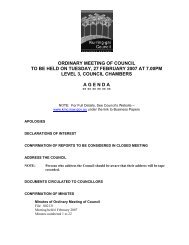Ku-ring-gai Heritage Conservation Areas North Inventory Sheet
Ku-ring-gai Heritage Conservation Areas North Inventory Sheet
Ku-ring-gai Heritage Conservation Areas North Inventory Sheet
Create successful ePaper yourself
Turn your PDF publications into a flip-book with our unique Google optimized e-Paper software.
<strong>Ku</strong>-<strong>ring</strong>-<strong>gai</strong><br />
<strong>Heritage</strong> <strong>Conservation</strong> <strong>Areas</strong> <strong>North</strong> <strong>Inventory</strong> <strong>Sheet</strong><br />
Item No<br />
Item Name<br />
Item Type<br />
Group Collection<br />
Category<br />
Key Historical<br />
Periods<br />
Primary Address<br />
Local Govt. area<br />
HCA 17 part<br />
PYMBLE HEIGHTS HERITAGE CONSERVATION AREA<br />
<strong>Heritage</strong> <strong>Conservation</strong> Area<br />
Urban Area<br />
Townscape<br />
Victorian, Federation, Inter-war<br />
Refer to map<br />
<strong>Ku</strong>-<strong>ring</strong>-<strong>gai</strong><br />
Boundaries<br />
The Pymble Heights <strong>Heritage</strong> <strong>Conservation</strong> Area encompasses properties at Nos. 35-45 Grandview<br />
Street, 2-14 Wellesley Avenue, 2 & 4 Mocatta Avenue, Nos. 11 and 11A and 31 King Edward Street,<br />
Nos. 10-24 King Edward Street, Nos. 19-33 Church Street, Nos.10-20 Church Street, and Nos. 5-13<br />
Station Street, Pymble.<br />
Summary<br />
Statement of<br />
Significance<br />
National Historic Themes<br />
State Historic Theme 1<br />
State Historic Theme 2<br />
State Historic Theme 3<br />
State Historic Theme 4<br />
Building settlements towns and cities<br />
Towns, suburbs and villages<br />
A largely intact portion of the 1892 Pymble Heights Estate subdivision encompassing 18 listed<br />
heritage items, particularly intact Victorian, Federation and Inter-war period housing. The area is of<br />
aesthetic significance for its fine groups of Victorian, Federation period and Inter war period<br />
houses, outstanding groups including the group of heritage items at Nos. 35-45 Grandview Street<br />
and 2 Wellesley Road (Corner Grandview Street) which illustrate the transition from Victorian to<br />
Federation period architectural styles; and the group of heritage items at 19-33 Church Street, an<br />
impressive group of high quality houses built from the 1890s on a ridge top affording district views:<br />
these Church Street houses were particularly prominent in historic photos c. 1900 taken from<br />
Grandview or King Edward Streets looking north. The Pymble Heights heritage conservation area<br />
is of historical significance as it represents the high quality housing development for wealthy<br />
families which followed closely on the opening of Pymble railway station on 1 January 1890. Both<br />
Hoffbank at 33 Church Street and Kiewa at 29 Church Street, were constructed for the wealthy<br />
woolbroker Duncan Carson.<br />
The name <strong>Ku</strong>-<strong>ring</strong>-<strong>gai</strong> comes from the <strong>Ku</strong><strong>ring</strong><strong>gai</strong> or Gu<strong>ring</strong>ai Aboriginal language group of the people<br />
who inhabited the area from Port Jackson north across Broken Bay and beyond Brisbane Water. The<br />
name has been adopted for both the Local Government area and the adjacent National Park to the<br />
north. There were two bands of the Gu<strong>ring</strong>ai in what is now the <strong>Ku</strong>-<strong>ring</strong>-<strong>gai</strong> Local Government area:<br />
the Garrigal or Carigal people, who lived around West Head, and the Terramerragal, who lived in the<br />
Turramurra area.<br />
A ridge-top pathway made by the Gu<strong>ring</strong>ai people was the route followed by what is now the Pacific<br />
Highway through <strong>Ku</strong>-<strong>ring</strong>-<strong>gai</strong>.<br />
Within six weeks of the arrival of the British First Fleet in Sydney in 1788, Governor Phillip went<br />
explo<strong>ring</strong> around Broken Bay, and commented on the friendliness of the Aboriginal people. However,<br />
when he returned a year later, all except those too sick with smallpox fled from him. By 1790, over<br />
KU-RING-GAI HERITAGE CONSERVATION AREAS NORTH INVENTORY

















